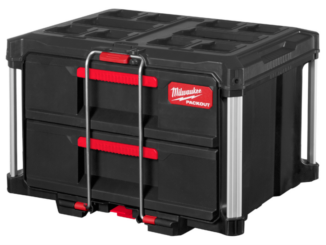Power tools have revolutionized the way we work, making complex and labor-intensive tasks seem like child’s play. These incredible machines are the backbone of many industries, from construction to woodworking, and even in our daily DIY projects.
In this article, we’ll delve into the world of power tools, exploring their history, evolution, and the wide array of applications they serve.
A Historical Perspective
The concept of power tools dates back to ancient times, where simple machines were used to reduce human effort. The earliest known power tool was the water wheel, which harnessed the energy of flowing water to grind grain and perform other tasks. Waterwheels and windmills were the precursors to the modern power tool, utilizing natural energy sources to perform mechanical work.
It wasn’t until the late 19th and early 20th centuries that power tools as we know them began to take shape. The advent of electricity and the development of electric motors revolutionized the industry. The electric drill, for instance, was one of the first widely adopted power tools. It allowed for more precise and efficient drilling than manual methods.
As the 20th century progressed, power tools evolved rapidly, introducing innovations such as cordless technology, variable speed settings, and ergonomic designs. Today, power tools are more versatile and powerful than ever, thanks to advances in engineering and manufacturing.
The Modern Power Tool Landscape
The modern power tool market is a vast and diverse landscape, catering to a wide range of industries and applications. Here are some of the most common types of power tools and their primary uses:
- Drills: Electric drills are essential tools in construction, woodworking, and DIY projects. They can be used for drilling holes and driving screws, and there are various types of drill bits available to suit different materials.
- Saws: Circular saws, jigsaws, and reciprocating saws are invaluable for cutting materials like wood, metal, and plastic with precision. In construction, these tools are used to make straight or curved cuts quickly and accurately.
- Sanders: Sanders are used to smooth surfaces by removing layers of material. Belt sanders, orbital sanders, and detail sanders are commonly used in woodworking and finishing work.
- Grinders: Angle grinders are versatile tools used for cutting, grinding, and polishing metal, stone, and concrete. They are essential in metal fabrication and construction.
- Routers: Routers are used in woodworking to hollow out an area in a piece of wood, creating decorative edges or joints. They are versatile and precise tools.
- Nail Guns: Nail guns are a staple in construction and carpentry, allowing for quick and efficient nailing without the need for a hammer.
- Impact Wrenches: These tools are designed to provide high torque for loosening or tightening bolts and nuts, commonly used in automotive repair and construction.
- Rotary Tools: Rotary tools like the Dremel offer exceptional precision for tasks such as engraving, carving, and detail work.
- Power Screwdrivers: Power screwdrivers are a time-saving alternative to manual screwdrivers, making tasks such as assembling furniture much easier.
- Planers: Planers are used to smooth and level the surfaces of wooden boards, making them ideal for carpentry and cabinetry.
- Cordless Tools: Many power tools are now available in cordless versions, using rechargeable lithium-ion batteries. This provides flexibility and portability for jobs in remote locations.
- Multifunction Tools: Multifunction tools, like oscillating multi-tools, combine several functions in one machine, making them versatile and space-saving.
Advantages of Power Tools
Power tools have several advantages over traditional hand tools, making them indispensable in many professional and DIY applications:
- Efficiency: Power tools significantly reduce the time and effort required to complete tasks, increasing productivity.
- Precision: Many power tools offer precise control, enabling accurate cuts, holes, and finishes.
- Versatility: The wide range of power tools available means there’s a tool for almost every job, reducing the need for manual labor.
- Consistency: Power tools provide consistent results, ensuring that each piece is identical to the next, which is crucial in manufacturing and construction.
- Reduced Physical Strain: Using power tools can lessen the physical strain on workers, reducing the risk of repetitive stress injuries.
- Portability: Cordless power tools offer the flexibility to work in remote locations without access to a power source.
- Innovation: Continuous advancements in power tool technology lead to improved performance and new features.
Safety Considerations
While power tools offer numerous benefits, they can also be dangerous if not used correctly. Here are some safety considerations to keep in mind:
- Read the Manual: Always read the manufacturer’s instructions and follow safety guidelines.
- Wear Safety Gear: Use appropriate safety gear, including safety glasses, hearing protection, dust masks, and gloves, depending on the tool and the task.
- Inspect Tools Regularly: Check your power tools for damage, wear, and proper functioning before use.
- Secure Workpieces: Ensure that the workpiece is securely clamped or held in place to prevent unexpected movements.
- Keep Workspaces Clean: Cluttered workspaces can lead to accidents. Keep your area tidy and well-organized.
- Disconnect Power: When changing accessories or performing maintenance, always disconnect the power source.
- Be Mindful of Cords: When using corded tools, be aware of the power cord’s location to avoid tripping hazards.
- Proper Training: Seek proper training if you are not familiar with a particular power tool or task.
Conclusion
Power tools have come a long way from their humble origins as water-driven machines. Today, they are essential components in various industries and everyday DIY projects, offering unparalleled efficiency, precision, and versatility.
As technology continues to advance, we can expect even more innovations in power tools, making our lives easier and our projects more achievable.
However, it is important to remember that safety should always be a priority when working with these powerful machines. With the right knowledge, skills, and precautions, power tools can unlock incredible potential, helping us build, create, and innovate like never before.

